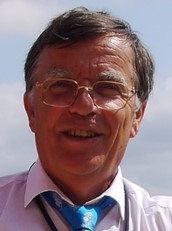
EAEEIE 2022
31st Annual Conference of the European Association for Education in Electrical and Information Engineering (EAEEIE)
29 June - 1 July 2022 | Coimbra, Portugal

ISEC - Coimbra Institute of Engineering
Keynote 1 - Wednesday, 29th June, 9h30 AM

Prof. Olivier Bonnaud
GIP-CNFM and University of Rennes 1
Grenoble, France and Rennes, France
Electronics and Microelectronics challenges for facing the digital society limitations
Abstract
For economic, political, and strategic reasons, governments,
including the European ones, are
developing digital technology in more and more activities.
Indeed, we are witnessing an exponential
growth in the production of online administrative documents with many
redundancies. At the same time,
the media are increasingly implementing online information in the
form of podcasts and videos with
individualized digital distribution systems. On the industrial level,
new connected products are multiplying
as part of the development of a so-called 4.0 industry, mainly using
connected robots.
This industrial revolution involves multiple data centers that
store, duplicate and sort data using
artificial intelligence approaches. Without dwelling on the societal
consequences affecting the conviviality
but also the quality of exchanges of a more professional, technical,
technological and scientific nature, it
is necessary to analyze the direct consequences on the quantity of data
to process, transmit and store. All
these digital products, most of which are controlled or processed by
software via processors, need an
increasingly fast, high-performance physical support with fabulous
memory capacity. The growth of needs
is exponential and so is the associated energy consumption.
The consequence is to have electronics which are more and
more integrated in order to have an
increased storage and processing capacity, whose frequency performances
are increased but whose real
consumption per transferred bit must be increasingly low; a division by
ten seems a minimum required. It
is therefore the performance of microelectronics that must be
increased. Several limits appear in this
evolution which is currently unavoidable. The first is
technological, insofar as the dimensions of the
elementary components in a plane for the densest integrated circuits are
approaching atomic distances. It
is thus necessary to introduce the third dimension, which opens up very
promising prospects but requires
a thorough review of the manufacturing and design processes. The second
limitation is related to the
growing exploitation of hybrid systems such as sensors or actuators that
combine several disciplines such
as mechanics, optics, thermics, microfluidics or biology. The approaches
are becoming multidisciplinary
and require new techniques to design, manufacturing and
testing. The third is linked to energy
consumption which, in its booming growth, risks leading to an economic
and societal collapse over the
next two decades. The fourth is linked to the depletion of natural
resources, in particular rare elements,
which are very costly and consume a lot of energy to extract and purify.
The last one is associated with
the human factor. More and more high-level skills are needed to face the
challenges. This explains the
presence of jobs in shortage in the field of microelectronics, whether
at the technician, engineer or doctor
level in the industrial sector, but also in research and teaching.
A strategy must therefore be pursued to train all these specialists at
different levels. This is the primary
role of higher education worldwide. These specialists need solid
knowledge with a very good background,
but also know-how in an increasingly complex and expensive technical and
technological environment.
The new skills must be increasingly multidisciplinary and gradually
become mandatory. This is why, at
the French level, for many years, microelectronics and nanotechnology
training has been organized at the
national level to pool platforms and train future graduates on
innovative topics in line with the evolution
of techniques. This justifies the national coordination for higher
education in microelectronics, the GIP-
CNFM network.
This keynote will first address the various limitations and challenges
associated with the development
of widespread digitization. Then, it will describe the approach
adopted by the national network in
conjunction with its industrial partners to meet the challenges and
increase the pool of skills necessary for
the development of industry and innovation.
Biography
Olivier Bonnaud, born in 1950 in France, was successively a student at the Ecole Normale Supérieure de Cachan (France), doctor in microelectronics, doctor "es-science". In 1984, he became a full professor at the University of Rennes 1 and Supelec ("Grande Ecole") in the field of microelectronics. He then created a research laboratory (Microelectronics Laboratory, currently a department of the Institute of Electronics and Digital technologies, UMR CNRS 6164, Rennes - IETR) which he runs until 2013, and several postgraduate and doctoral courses (masters, university degrees). He was Director of Doctoral Studies at the University of Rennes 1 for 10 years. In terms of both research and teaching, he has published or presented more than 600 articles and written or co-written 7 books. He has been chairman or co-chairman of more than 25 international conferences and more than 25 national conferences. Founder in 1985 of the "West Microelectronics Common Center (CCMO)", he was the director of this center until 2010, when he was appointed by the French Minister of Higher Education, Executive Director of the GIP-CNFM, Public Interest Group - "National Coordination for Education in Microelectronics and Nanotechnologies". Since then, he has coordinated this network of 12 French interuniversity training centers in microelectronics and nanotechnology, which host more than 16,000 students per year for practical training. As part of his many international cooperations, he was promoted as a foreign international expert on the "1000 talents" program by the Chinese government in 2013. Since 2013, he has been Professor Emeritus of the University of Rennes 1 and Permanent Visiting Professor of the South-East University of Nanjing (China). He is past-President and Honor President of the French EIE association (EEA), past-President and Honor president of EAEEIE association, and since 2010 President of Microelectronics French association (CNFM).